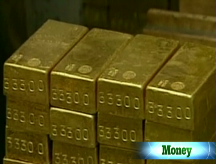Gold tops $1,000 an ounce
The precious metal rallies to its highest level since March 2008 as investors flock to safety.
NEW YORK (CNNMoney.com) -- Gold prices rose to a record high above $1,007 an ounce Friday as stocks continued to fall and investors flocked to the metal to preserve capital.
Gold for February delivery rose $25.70 to settle at $1001.80 an ounce on the New York Mercantile Exchange.
April gold, which has surpassed the February contract in trading volume, rose to a high of $1,007.70 at one point during the session.
The last time gold traded at such high levels was in March 2008 amid volatile financial markets and inflation concerns. It rose to an all-time trading high of $1,014.60 an ounce on March 17 and settled at a record $1,003.20 an ounce on March 18.
Still, gold remains well below its inflation-adjusted highs touched during a spike nearly 30 years ago. Gold rose to $825.50 on Jan. 21, 1980, which is $2,186.50 in today's dollars, according to the Minneapolis Fed Calculator.
Many investors view gold as a safe haven because precious metals tend to hold value during times of economic duress. As a result, gold often rallies when stock prices retreat.
"With the Dow down to a six-year low and concerns about financial and economic stability worldwide, $1,000 seems to be the new resistance level," said Carlos Sanchez, precious metals analyst at CPM Group in New York.
Sanchez said gold could push higher toward the close of trading, and that it could continue rising over the next few weeks, "given what's going on with stocks."
Stocks continued to slide Friday morning, one day after the Dow Jones industrial average fell to its lowest level in six years, as shares of financial institutions led the market lower.
The blue-chip average ended Thursday's session at the lowest point since Oct. 9, 2002, the low of the last bear market, and it was down another 2.8% with about three hours left in Friday's session.
Stocks have been falling over the last few weeks, and gold has been rising, as investors expressed doubts about the government's ability to lift the economy out of one of the longest recessions on record.
The jittery tone on Wall Street comes despite a number of new government initiatives announced this week.
President Obama unveiled a $75 billion foreclosure prevention plan Wednesday designed to aid 9 million distressed homeowners and jolt the housing market out of its stupor. That came after Obama signed a $787 billion economic stimulus plan into law Tuesday.
Meanwhile, cash-strapped automakers General Motors (GM, Fortune 500) and Chrysler LLC. asked for another $21.6 billion Tuesday in addition to the $17.4 billion in government assistance they have already received to stay afloat.
Adding to the bleak tone, Treasury Secretary Tim Geithner outlined a bank bailout plan last week that was considered to be short on detail. ![]()



